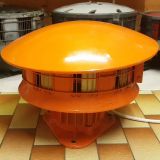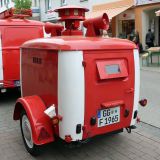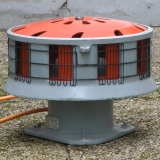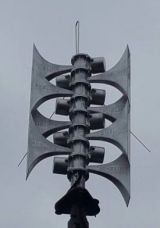HELIN: Difference between revisions
(Created page with "''Hagen Electrical and Communication Technology'' (German: ''Hagener Elektro- u. Kommunikationstechnik'', doing business as '''HELIN''') is based in Hagen, NW. HELIN is primarily involved with electric and electrotechnical products and services and has been in business since 1923. Their siren division, HELIN Siren, has been in operation since 2015; HELIN was one of the producers of the E57 and faded away as far as sirens were concerned after the 1970s, but their recent f...") |
No edit summary |
||
| Line 1: | Line 1: | ||
''Hagen Electrical and Communication Technology'' (German: ''Hagener Elektro- u. Kommunikationstechnik'', doing business as '''HELIN''') is based in Hagen, NW. HELIN is primarily involved with electric and electrotechnical products and services and has been in business since 1923. Their siren division, HELIN Siren, has been in operation since 2015; HELIN was one of the producers of the E57 and faded away as far as sirens were concerned after the 1970s, but their recent foray into the electronic siren market has proven to be a fruitful one. HELIN is a relatively small player regionally due to their small presence and semi-recent siren establishment, although their existing siren systems have proven to be very reliable in the areas of which they serve. | {{Infobox manufacturer|names=<div>Hagen Electricity Industry (1923-?) | ||
<div>Hagen Electrical and Communication Technology (?-present) | |||
<div>HELIN|founded=1923|products=<div>Electrical engineering and electrical installations | |||
<div>Communication and communications technology | |||
<div>Cable and pipeline civil engineering | |||
<div>Sirens – Warning Systems / Warning System Technology|hq=Hagen, NW|title=Hagen Electrical and Communication Technology | |||
----Hagener Elektro- u. Kommunikationstechnik | |||
----HELIN|image=HELIN logo.png|caption=HELIN's primary logo.}}''Hagen Electrical and Communication Technology'' (German: ''Hagener Elektro- u. Kommunikationstechnik'', doing business as '''HELIN''') is based in Hagen, NW. HELIN is primarily involved with electric and electrotechnical products and services and has been in business since 1923. Their siren division, HELIN Siren, has been in operation since 2015; HELIN was one of the producers of the E57 and faded away as far as sirens were concerned after the 1970s, but their recent foray into the electronic siren market has proven to be a fruitful one. HELIN is a relatively small player regionally due to their small presence and semi-recent siren establishment, although their existing siren systems have proven to be very reliable in the areas of which they serve. | |||
== History == | == History == | ||
| Line 12: | Line 19: | ||
=== Siren Loudspeaker Single Axle Trailer === | === Siren Loudspeaker Single Axle Trailer === | ||
''Main article: [[SLEA]]'' | ''Main article: [[SLEA]]'' | ||
[[File:SSSAT 52 2.jpg | [[File:SSSAT 52 2.jpg|thumb|160x160px|An SLEA 62 photographed by Hans-Jürgen Pilgerstorfer.]] | ||
The ''Siren Loudspeaker Single Axle Trailer'' (German: ''Sirene-Lautsprecher-Einachs-Anhänger'', abbreviated '''SLEA''') refers to 2 omnidirectional mobile gas-powered mechanical sirens produced by [[HELIN]] from 1952 to 1965. These were intended for use in the event power would not be readily available or reliable. The ''Siren Loudspeaker Single Axle Trailer 1952'' (German: ''Sirene-Lautsprecher-Einachs-Anhänger 1962'', abbreviated '''SLEA 52''') consists of a DS55 omnidirectional siren, two Siemens and Halske speakers, a Westfalia and Wiedenbrück trailer on a chassis with 2 wheels, and a multi-purpose 5.2 kW ILO L 250 engine for power. The trailer includes controls, storage compartments, and a fuel tank, with speaker controls housed in the towing vehicle. Organizations painted the SLEA 52 in distinctive colors based on ownership, including orange (Federal Office of Civil Protection and Disaster Assistance (German: ''Bundesamt für Bevölkerungsschutz und Katastrophenhilfe'', abbreviated ''BBK'')), blue (Federal Agency for Technical Relief (German: ''Bundesanstalt Technisches Hilfswerk'', abbreviated ''THW''), and fire defense (German: ''Feuerwehr''); very few remain in their original colors. In 1963, the ''Siren Loudspeaker Single Axle Trailer'' 1962 (German: ''Sirene-Lautsprecher-Einachs-Anhänger 1962'', abbreviated '''SLEA 62''') SLEA 62 was introduced as an improved version. It features two doors, a ventilation fan with cover to better airflow, extendable support legs, and internal components from Kaiser. Telefunken replaced Siemens speakers to reduce weight, and minor adjustments were made. Aside from these updates, the SLEA 62 remains similar to the SLEA 52. | The ''Siren Loudspeaker Single Axle Trailer'' (German: ''Sirene-Lautsprecher-Einachs-Anhänger'', abbreviated '''SLEA''') refers to 2 omnidirectional mobile gas-powered mechanical sirens produced by [[HELIN]] from 1952 to 1965. These were intended for use in the event power would not be readily available or reliable. The ''Siren Loudspeaker Single Axle Trailer 1952'' (German: ''Sirene-Lautsprecher-Einachs-Anhänger 1962'', abbreviated '''SLEA 52''') consists of a DS55 omnidirectional siren, two Siemens and Halske speakers, a Westfalia and Wiedenbrück trailer on a chassis with 2 wheels, and a multi-purpose 5.2 kW ILO L 250 engine for power. The trailer includes controls, storage compartments, and a fuel tank, with speaker controls housed in the towing vehicle. Organizations painted the SLEA 52 in distinctive colors based on ownership, including orange (Federal Office of Civil Protection and Disaster Assistance (German: ''Bundesamt für Bevölkerungsschutz und Katastrophenhilfe'', abbreviated ''BBK'')), blue (Federal Agency for Technical Relief (German: ''Bundesanstalt Technisches Hilfswerk'', abbreviated ''THW''), and fire defense (German: ''Feuerwehr''); very few remain in their original colors. In 1963, the ''Siren Loudspeaker Single Axle Trailer'' 1962 (German: ''Sirene-Lautsprecher-Einachs-Anhänger 1962'', abbreviated '''SLEA 62''') SLEA 62 was introduced as an improved version. It features two doors, a ventilation fan with cover to better airflow, extendable support legs, and internal components from Kaiser. Telefunken replaced Siemens speakers to reduce weight, and minor adjustments were made. Aside from these updates, the SLEA 62 remains similar to the SLEA 52. | ||
Revision as of 19:52, 27 October 2024
Hagen Electrical and Communication Technology (German: Hagener Elektro- u. Kommunikationstechnik, doing business as HELIN) is based in Hagen, NW. HELIN is primarily involved with electric and electrotechnical products and services and has been in business since 1923. Their siren division, HELIN Siren, has been in operation since 2015; HELIN was one of the producers of the E57 and faded away as far as sirens were concerned after the 1970s, but their recent foray into the electronic siren market has proven to be a fruitful one. HELIN is a relatively small player regionally due to their small presence and semi-recent siren establishment, although their existing siren systems have proven to be very reliable in the areas of which they serve.
History
HELIN was founded as Hagen Electricity Industry (German: Hagener Elektrizitäts-Industrie, abbreviated HELIN) on October 9th, 1923, in Hagen, NW. HELIN's main focus has been the assembly and service of electrotechnical products, with electric motors being one of HELIN's biggest industries at the time of its foundation. While not very much information is known about HELIN's history, they produced an omnidirectional mobile gas-powered mechanical siren in 1952 named the Siren Loudspeaker Single Axle Trailer 1952 (German: Sirene-Lautsprecher-Einachs-Anhänger, abbreviated SLEA 52), intended for use in the event power would not be readily available or reliable. The DS55, which was a component of the SLEA, was also sold separately but was not a popular choice. HELIN was one of the companies that produced the E57 starting in the late 1950s or early 1960s and supposedly ending in 1975 when DIN 41096 expired. The SLEA 52 would later be refined into the Siren Loudspeaker Single Axle Trailer 1962 (German: Sirene-Lautsprecher-Einachs-Anhänger, abbreviated SLEA 62), which featured minor design changes for maximized efficiency. The SLEA sirens sold decently well but are very uncommon today, with most in the hands of collectors.
Products
DS55

The Three-Phase Siren 1955 (German: Drehstom Sirene 1955[1], abbreviated DS55) is a small omnidirectional 220/380 V 1.4 kW (1.8 hp) siren modelled after the L52 with minor differences. Like the L52, the DS55 is a 9-port siren, with a 3ϕ 50 Hz 220/380 V 1.4 kW (1.8 hp) electric motor underneath the stator that draws 2.7-4.7 A and drives the rotor at around 2800 rpm. HELIN outsourced production of DS55 rotors and stators to Garthe, a casting company based in Ennepetal. A flange below the stator directs the siren's sound downwards and outwards and has a rotation arrow cast on, which displays the correct way the rotor was supposed to spin. A triangular base below the motor with 3 holes in each corner allows the DS55 to be bolted to a flat surface. A protective dome, which is smaller and less pronounced compared to the L52's, both shielded the siren from the elements and propagated the siren's output downwards. The DS55 is smaller in size (around 39 cm (15.3 in) in diameter compared to the 50 cm (19.6 in) L52) and weight (around 35 kg (77.1 lbs) compared to the ~60 kg (132.2 lbs) L52)[2]; despite the DS55's small size, it has been described as just as loud, if not louder, than the L52/E57. The DS55 also utilizes a different motor and smaller rain shield. The DS55 seems to have been made exclusively for the Siren Loudspeaker Single Axle Trailer sirens but could be ordered separately if desired. DS55 sirens on SLEA units were painted in a variety of different colors depending on what organization owned the siren; for instance, units owned by the Federal Office of Civil Protection and Disaster Assistance (German: Bundesamt für Bevölkerungsschutz und Katastrophenhilfe, abbreviated BBK) were orange, units owned by the Federal Agency for Technical Relief (German: Bundesanstalt Technisches Hilfswerk) were blue, and units owned by the fire defense (German: Feuerwehr) were red. Very few DS55 sirens have remained in their original colors. SLEA units are today very uncommon, and even less standalone DS55s exist. A very small number of these are still in service as fire sirens, while others are in the hands of private owners.
Siren Loudspeaker Single Axle Trailer
Main article: SLEA

The Siren Loudspeaker Single Axle Trailer (German: Sirene-Lautsprecher-Einachs-Anhänger, abbreviated SLEA) refers to 2 omnidirectional mobile gas-powered mechanical sirens produced by HELIN from 1952 to 1965. These were intended for use in the event power would not be readily available or reliable. The Siren Loudspeaker Single Axle Trailer 1952 (German: Sirene-Lautsprecher-Einachs-Anhänger 1962, abbreviated SLEA 52) consists of a DS55 omnidirectional siren, two Siemens and Halske speakers, a Westfalia and Wiedenbrück trailer on a chassis with 2 wheels, and a multi-purpose 5.2 kW ILO L 250 engine for power. The trailer includes controls, storage compartments, and a fuel tank, with speaker controls housed in the towing vehicle. Organizations painted the SLEA 52 in distinctive colors based on ownership, including orange (Federal Office of Civil Protection and Disaster Assistance (German: Bundesamt für Bevölkerungsschutz und Katastrophenhilfe, abbreviated BBK)), blue (Federal Agency for Technical Relief (German: Bundesanstalt Technisches Hilfswerk, abbreviated THW), and fire defense (German: Feuerwehr); very few remain in their original colors. In 1963, the Siren Loudspeaker Single Axle Trailer 1962 (German: Sirene-Lautsprecher-Einachs-Anhänger 1962, abbreviated SLEA 62) SLEA 62 was introduced as an improved version. It features two doors, a ventilation fan with cover to better airflow, extendable support legs, and internal components from Kaiser. Telefunken replaced Siemens speakers to reduce weight, and minor adjustments were made. Aside from these updates, the SLEA 62 remains similar to the SLEA 52.
More in depth information can be found in the SLEA article, linked above.
E57
Main article: E57

HELIN was one of the manufacturers of the E57, the German "standard siren" that was originally developed by Elektror in 1957. The E57 features a 9-port rotor and stator, with a grille from the L52 to block debris. HELIN outsourced production of their E57' rotors and stators to Garthe, a casting company based in Ennepetal. The E57's rotor has thicker walls than the L52, enhancing range slightly, and a flange below the stator directs sound downwards and outwards. A rotation arrow on the stator indicates the correct spin direction, similar to the L52's motor arrow. Powered by a 220/380 V 5 kW (6.7 hp) 3-phase motor, the E57 reaches around 2800 rpm within 2-4 seconds. The E57 is painted granite grey (RAL 7026) per DIN 41096 standards, while the rotor is coated with unspecified polyamide paint. Unlike the L52, the E57 lacks protective conductor connections to simplify production. It retains the L52’s cost-effective design, with a large fiberglass-reinforced roof for durability and lighter weight, avoiding dents common in the L141/L52 models. Some of HELIN's E57s had roof mounts which weren't recessed into the stator, unlike most of the other manufacturers. The stator has no grille attachment holes, and a triangular base with bolt holes allows easy mounting. The motor flanges are straight, differing from the L52’s curved ones. DIN 41097-compliant, the E57 offers tripod, pole, and roof mount options for versatile installation. HELIN allegedly still produces the E57; although their main website mentions it as an option, no further mentions of the siren can be found on either HELIN proper's website or HELIN Sirens' website.
More in depth information can be found in the E57 article, linked above.
Self-sufficient siren systems
UNITAS
SOLITARIAS
Electronic sirens
SONUS
Main article: SONUS

SONUS (model name SONUS-HES or HES) is a HELIN siren brand introduced by 2015. Featuring corrosion-resistant, triangular-profile horns, SONUS operates with 150 W drivers shielded in cylindrical enclosures, inspired by HÖRMANN's ECN design for efficiency. With configurations from 2 to 20 speakers (300 W to 3000 W), the setup supports omnidirectional sound using gap diffraction. Powered by 110-250 V AC/12 V DC and 2 AGM batteries, SONUS uses up to 10 Class D amplifiers, with optional reserve amplifier switching. An SD card enables signal storage and optional live PA. HELIN's VEKTRA software integrates remote monitoring, while activation options include GSM, Ethernet, telephone line, or radio frequency. SONUS has IP55-rated control components, outputs 103-123 dBa at 30 m, and operates between -25°C to +65°C. Formerly related to Telegrafia’s hardware, HELIN switched to SiRcom amplifiers in 2022. SONUS dimensions range from 600 x 380 x 300 mm to 600 x 770 x 300 mm and weigh between 23-105 kg, depending on battery inclusion.
More in depth information can be found in the SONUS article, linked above.
SONITUS
SONUS was formerly accompanied by another series of sirens named the SONITUS, which was advertised as a "simpler" electronic siren that was integrable into other forms of notification such as SMS messaging and emergency lighting. This series was visually identical to the SONITUS but lacked a 3000 W model. Featuring corrosion-resistant, triangular-profile horns, SONITUS operates with 150 W drivers shielded in cylindrical enclosures, inspired by HÖRMANN's ECN design for efficiency. With configurations from 2 to 16 speakers (300 W to 2400 W), the setup supports omnidirectional sound using gap diffraction. Powered by 110-250 V AC/12 V DC and 2 AGM batteries, SONITUS uses up to 8 Class D amplifiers, with optional reserve amplifier switching. An SD card enables signal storage and optional live PA. HELIN's VEKTRA software integrates remote monitoring, while activation options include GSM, Ethernet, telephone line, or radio frequency. SONUS has IP55-rated control components, outputs 103-121 dBa at 30 m, and operates between -25°C to +65°C. The SONITUS was short-lived, being removed from HELIN's siren website between July and October of 2016, and no units are known to exist.
MOBILUS
Footnotes
- ↑ It's unknown if the "55" in "DS55" means 1955; the SLEA 52, as the name suggests, was most likely introduced in 1952; if this is true, then the DS55 could not have been introduced in 1955.
- ↑ Sirene Helin DS55 | Vorstellung und Probelauf
